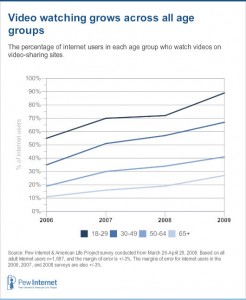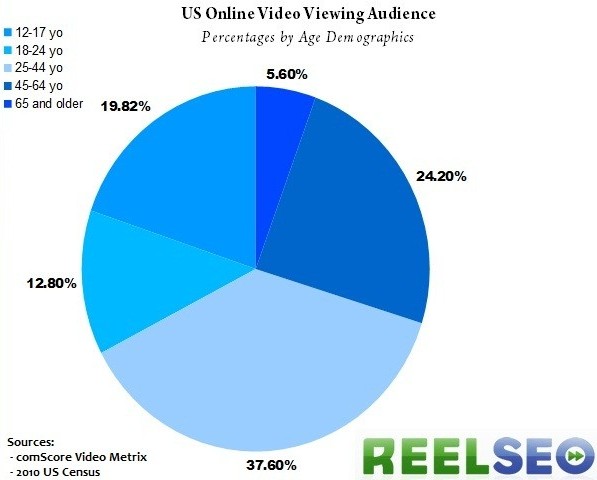The demographic reach of online video – who views most? / part II
…And we’re back. Today’s segment is Part II of the Demographic Reach of Video Marketing series.* Sit tight, all you video marketing enthusiasts, as we dispel some rumors about who and how many people are online streaming video:
Last week I suggested that the bulk of online video viewers are in the 18-35 age range. Upon further study I discovered this is mostly true. But there were a few categories of consumers that are often overlooked, and I found some surprising statistics about them:
Left is a graph I found that shows the growth of online video viewers between the years 2006 and 2009. Did you realize that in just one year (2008-2009), there was a nearly 20% increase in young adult viewers of online video? Also, during the same year there were as much as 10% increases among adults and even the elderly.Though young adults are well aware they can catch up on their favorite media with the click of a mouse or swipe of a finger, older demographics are slowly realizing they can watch their favorite clips of Coach for free on YouTube or entire episodes for a mere $8/month on Netflix; saving them thousands per year on their satellite subscriptions (you’ve heard nothing good is ever on TV these days anyway). Though their numbers may seem significantly smaller than their young adult counterparts, the adult and elderly demographics are spending more time online each year (41% compared to 90%, respectively).
You may also be surprised to hear that teenagers do not make up the bulk of online viewers. Yes, that does mean they’re not the ones watching all those cat videos. That’s us.
Teenagers make up only 5.6% of online viewers, however once they pass into the 18-35 threshold, they tend spend about 14% more time online.
Take a look at this graph created by ReelSEO:
According to ReelSEO, the largest demographic of online video viewers are in the 25-44 age range. This holds pretty true with what I suggested in last week’s article. However, the second largest group is not the age group younger, but older. Consumers aged 45-64 spend almost double the amount of time online as young adults. Which can only mean this:
Though they’re still slow on the road, the adults and the elderly have the money and the fastest internet speeds – and that deserves some attention.
+Jessica Anderson can’t wait to spend more time browsing online and dropping dough.
*series is a somewhat loosely used term here.

